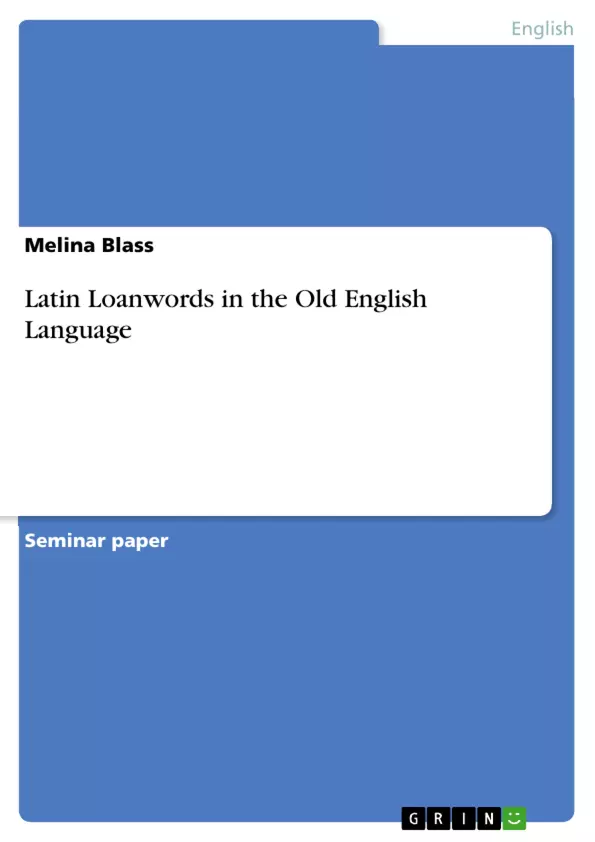How did Latin shape the development of the English language during its earliest stages? This paper examines the influence of Latin on Old English through three major periods of contact: the pre-Anglo-Saxon era, the Christianization of Britain, and later scholarly and ecclesiastical developments. With detailed examples and historical context, the study offers a clear and insightful overview of linguistic borrowing and cultural exchange. Ideal for students and readers interested in historical linguistics, English philology, and the roots of modern English.
Table of Contents
- 1. Introduction
- 2. Historical background
- 3. The Old English language
- 3.1 The Continental Period
- 3.2 The Settlement Period
- 3.3 Christianization Period
- 4. Conclusion
Objectives and Key Themes
This paper aims to explore the influence of Latin loanwords on the development of Old English. It investigates the historical context surrounding the adoption of these loanwords, categorizing them into distinct periods based on historical events and cultural exchange. The paper seeks to provide a deeper understanding of how these loanwords shaped the vocabulary of Old English and ultimately contributed to the English language we know today.
- The historical development of the Old English language.
- The impact of Latin loanwords on Old English vocabulary.
- The categorization of Latin loanwords into distinct historical periods (Continental, Insular, Christian).
- The socio-cultural factors driving the adoption of Latin loanwords.
- The lasting legacy of Latin loanwords on Modern English.
Chapter Summaries
1. Introduction: This introductory chapter sets the stage for the paper by establishing the dynamic nature of language development, specifically focusing on Old English. It highlights the complex interplay of historical, social, and cultural influences that shaped Old English's evolution. The chapter emphasizes the importance of understanding these historical tipping points to grasp the language's resilience and adaptability. It introduces the paper's central focus: exploring the rich tapestry of Old English, including the significant influence of Latin loanwords on its vocabulary and the subsequent impact on Modern English.
2. Historical background: This chapter details five key historical periods that significantly impacted the Old English language: the Germanic invasions of Britain, the arrival of Christianity, the reign of King Alfred the Great, the influence of the Benedictine Reform, and the Norman Conquest. Each period is discussed in terms of its linguistic consequences, including the introduction of new dialects, the adoption of the Roman alphabet, the promotion of literacy, and the eventual shift towards Middle English. The chapter also touches upon the transition from oral to written forms of Old English and the role of Anglo-Saxon writers in shaping the language's written form.
3. The Old English language: This chapter introduces the significant presence of Latin loanwords in Old English, estimating their number at 600-700. It establishes a framework for categorizing these loanwords into three distinct periods: Continental, Insular, and Christian, foreshadowing a more detailed exploration of these periods in subsequent subchapters. The chapter lays the foundation for understanding the historical processes through which Latin vocabulary entered the Old English lexicon.
3.1 The Continental Period: This section focuses on the earliest interactions between Germanic tribes and the Roman Empire, highlighting how these contacts led to the initial influx of Latin words into the Proto-English language. It discusses the geographical context of these interactions, particularly around the Rhine and Gaul, emphasizing the cultural exchange and trade that facilitated the transfer of vocabulary. The chapter explains how the integration of Latin words reflected the adoption of new concepts and technologies from Roman civilization by the Germanic people.
Keywords
Old English, Latin loanwords, historical linguistics, language evolution, Germanic tribes, Roman Empire, Christianity, King Alfred the Great, Norman Conquest, vocabulary, cultural exchange, historical periods.
Frequently asked questions
What is the main topic of this text?
The text focuses on the influence of Latin loanwords on the development of Old English, examining the historical context and categorizing these loanwords into distinct periods.
What are the objectives of this text?
The objectives are to explore the influence of Latin loanwords on Old English, investigate the historical context, categorize them into periods, and provide a deeper understanding of how they shaped Old English vocabulary.
What are the key themes of the text?
The key themes include the historical development of Old English, the impact of Latin loanwords, the categorization of these loanwords, the socio-cultural factors driving their adoption, and their lasting legacy on Modern English.
What are the key historical periods discussed?
The text discusses five key historical periods: the Germanic invasions of Britain, the arrival of Christianity, the reign of King Alfred the Great, the influence of the Benedictine Reform, and the Norman Conquest.
How are Latin loanwords categorized in the text?
Latin loanwords are categorized into three distinct periods: Continental, Insular, and Christian.
What does the "Introduction" chapter cover?
The introductory chapter sets the stage for the paper by establishing the dynamic nature of language development in Old English, focusing on the interplay of historical, social, and cultural influences.
What does the "Historical background" chapter detail?
This chapter details five key historical periods that significantly impacted the Old English language and their linguistic consequences.
What does the "The Old English language" chapter discuss?
This chapter introduces the significant presence of Latin loanwords in Old English and establishes a framework for categorizing them into three distinct periods: Continental, Insular, and Christian.
What does the "The Continental Period" section focus on?
This section focuses on the earliest interactions between Germanic tribes and the Roman Empire, highlighting how these contacts led to the initial influx of Latin words into the Proto-English language.
What are the keywords associated with this text?
The keywords include Old English, Latin loanwords, historical linguistics, language evolution, Germanic tribes, Roman Empire, Christianity, King Alfred the Great, Norman Conquest, vocabulary, cultural exchange, and historical periods.
- Quote paper
- Melina Blass (Author), 2024, Latin Loanwords in the Old English Language, Munich, GRIN Verlag, https://www.grin.com/document/1574665



